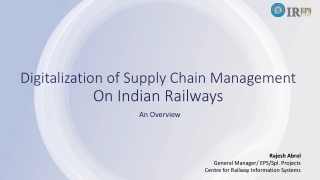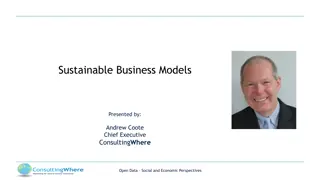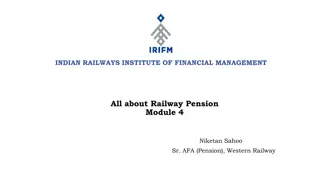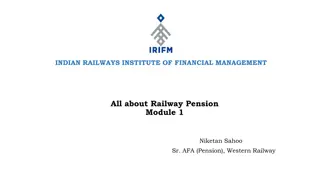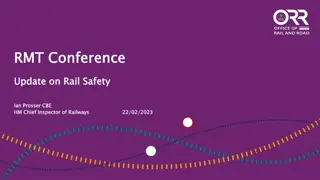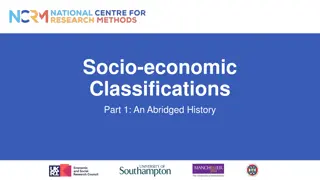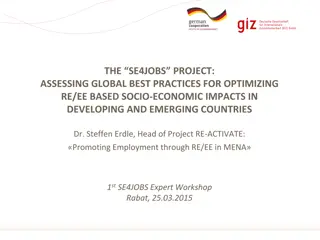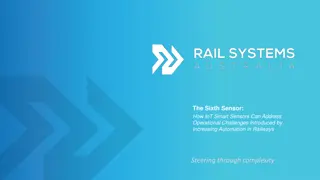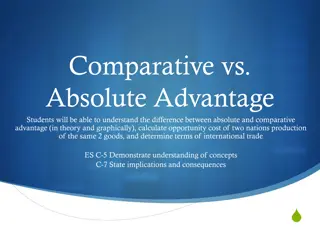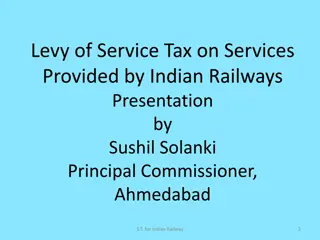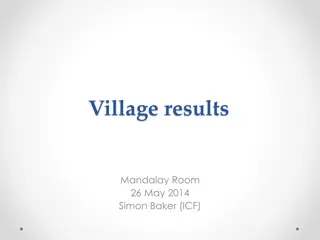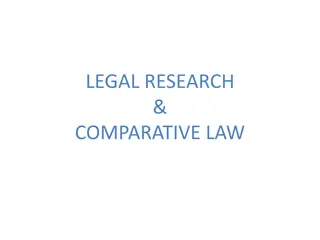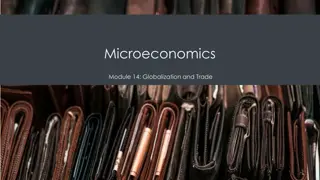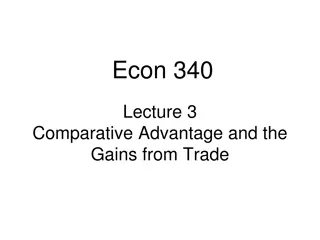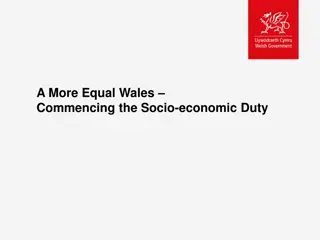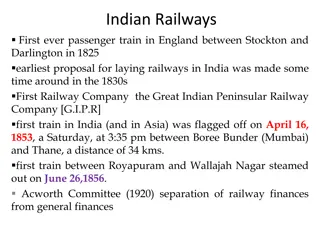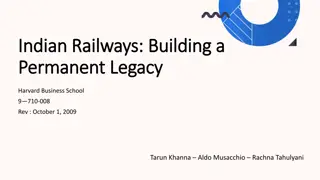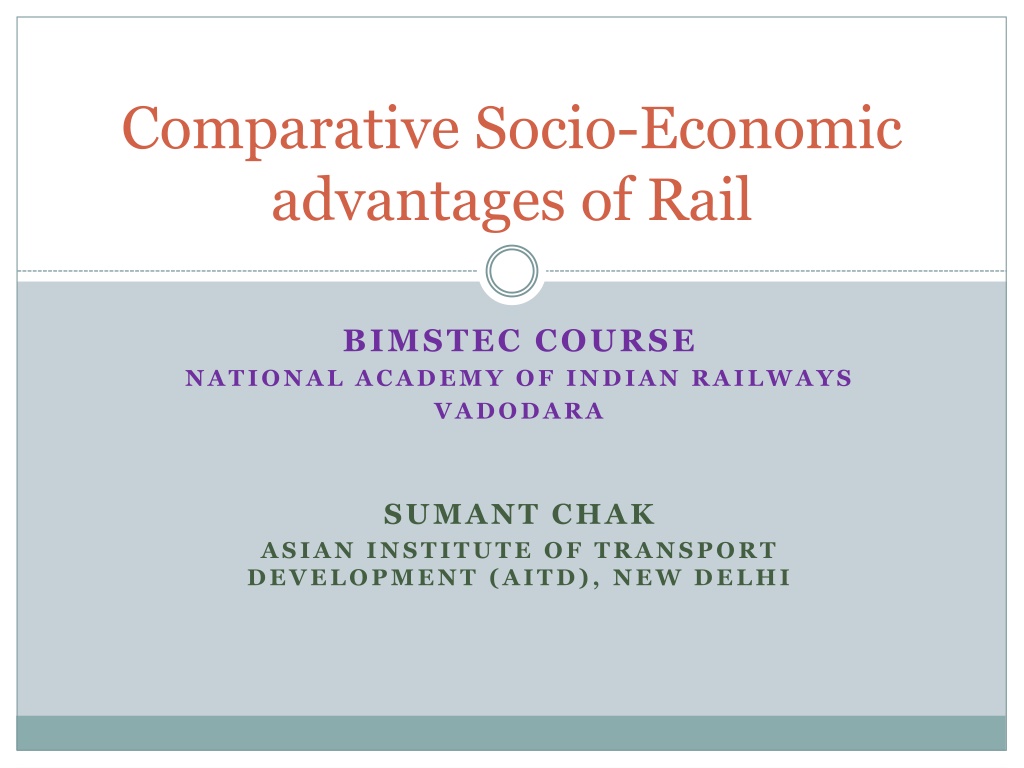
Comparative Socio-Economic Advantages of Rail Transportation in BIMSTEC Countries
Explore the comparative advantages of rail transportation in the BIMSTEC region, analyzing the impact on socio-economic factors such as trade-offs, environmental effects, and the global revival of rail. Understand the importance of rail in mass transport, cost-effectiveness, environmental considerations, and the worldwide shift towards sustainable transportation systems.
Download Presentation

Please find below an Image/Link to download the presentation.
The content on the website is provided AS IS for your information and personal use only. It may not be sold, licensed, or shared on other websites without obtaining consent from the author. Download presentation by click this link. If you encounter any issues during the download, it is possible that the publisher has removed the file from their server.
E N D
Presentation Transcript
Comparative Socio-Economic advantages of Rail BIMSTEC COURSE NATIONAL ACADEMY OF INDIAN RAILWAYS VADODARA SUMANT CHAK ASIAN INSTITUTE OF TRANSPORT DEVELOPMENT (AITD), NEW DELHI
Transport Choices Transport an integral part of economic and commercial activities. There are choices involved in respect of modes of transportation rail, road, air, ship or even non- motorized transport. Choice is driven by trade offs among prices, speed, safety, reliability and convenience for different modes. Supply price in a modal transport market and users cost are the determinants of choice.
Effect of Transport on Nature Transport activity causes stress on nature in the following ways: by drawing scarce resources fossil fuel, minerals, various non-metallic minerals and other materials like sand, stones, etc. and by using land, a) by giving rise to wastes like pollutant gases, solid wastes, noise, etc. which all flow back to nature that acts as a sink to absorb them, and b) by partitioning or destroying the ecosystem of the neighbourhoods of transport operation like farm land, wildlife, habitats, etc. c)
Status of Rail traffic? A number of countries have emphasised need for Railway to be the modal choice for mass transport Rail despite support lags behind road in market share of freight and passenger India has seen share of Rail in freight drop from 70% in 1970 to 24% in 2000 and passenger share from 36 % to 21 % in same period. Why then the revival of rail across the world?
Real cost of Transport Modes Rail is supposed to be superior mode of transport if we compare the true social costs of these two modes taking account of all the three development. Two reasons for variance: (a) Distortion in price structure: - Rail charges cover charges for both ground fixed infrastructure development as well as transport operation, while road transport charges do not properly reflect the road development charges. (b) Environmental externalities are different between the two modes, and the environmental segments of transport
Worldwide revival of Rail Environment a huge and real concern now Energy costs viewed as significant determinant of transport mode Safety cost now being appreciated Land usage a major factor in most countries Public awareness and organisations pushing governments towards sustainable transport systems
Climate Change There is overwhelming scientific evidence that the global climate is changing. The world is getting warmer, sea levels rising and snow cover reducing.
Comparative Study of Rail and Road by AITD in 2002 - a milestone Title of Study Environmental and Social Sustainability of Transport No study done earlier bringing together all costs including external costs of both modes Methodology adopted provided acceptable results Study provides insight for policy planners of the country Modal choice clearly established Based on socially optimal resource allocation Evolves guidelines for price setting
Issues flagged in Study Nature and Economy Transport and Environment Effects on Natural Resources Effect on Urban Air Quality Effect on Global Environment Effects on Coastal and Marine Environments Effects related to Disposal of Wastes
Development of Empirical model The development of the empirical model was based on the using fixed values of traffic of one mode compared to the other to work out energy consumed and polluting emissions with resultant health impacts and social costs on the basis of the following: - Representative sections - Road traffic flows - Rail traffic flows - Energy consumption
Energy Consumption and Pollutant Emissions The study focused on the following to obtain comparative data: - - Energy consumption Pollutant Emissions: Carbon Dioxide Carbon Monoxide Nitrogen Oxide Non-methane Volatile Organic Compounds Thereafter Intermodal substitution and its effect provided comparative details to consider
External Costs Important aspect of study as planners ignore this important factor in modal choice Covers cost of externalities on account of air pollution and accidents Urban population worst sufferers Cost of fatalities, injuries, damage to property Health costs due to pollution Correlates change in concentration level pollutant with change in mortality or morbidity Relevant social costs are derived from comparative analysis and intermodal substitution
Findings of the Study Freight Traffic Rail consumes much less energy than road particularly in freight - both in electric and diesel traction Rail consumes 75-90% less energy than road Imp Europe has a Marco Polo programme where anyone who enables transfer of 1 million tonne of traffic annually from road to rail is given money by a central fund
Figure 2: Energy Consumption Ranges in Freight Transport (Megajoules per NTKM) 1.8 1.6 1.4 1.2 1.0 0.8 0.6 0.4 0.2 0 Road Rail Rail Rail (Diesel traction) (Electric traction) (Composite)
Findings of the Study Passenger Traffic In comparison to road, rail consumes 5 to 21% less energy for passenger traffic. The reduced advantage is on account of dead weight of railway coaches which can weigh over 25 40 tonnes carrying just 5-6 tonnes of passengers when full Diesel bus is a close energy-efficient option in comparison to rail and is far more energy-efficient than passenger car.
Figure 1: Energy Consumption Ranges in Passenger Transport High end Average Low end (Megajoules per PKM) 0.45 0.40 0.35 0.30 0.25 0.20 0.15 0.10 0.05 0 Road (Car & Bus) Road (Bus only) Rail Rail Rail Road (Car only) (Diesel traction) (Electric traction) (Composite)
Important Basis of Comparison For comparative analysis, energy consumption on both the modes is inclusive of the energy used at thermal power plants and oil refineries in the generation of electrical energy and production of fuel used for locomotion.
Findings of the Study Financial Costs Costs of rail generally lower than road. Advantage greater for freight than for passenger traffic. Differential between road and rail costs for passenger traffic (base year 2000) is Rs 1.62 per PKM. For freight it increases to Rs2.09 per NTKM. For passenger traffic, cost on rail between Rs 1.10 and Rs 1.48 per PKM, while in the case of diesel bus, it is between Rs 1.04 and Rs2.89 per PKM. The comparative advantage of rail declines in a situation where adequate road capacity.
Findings of the Study Financial Costs Substantial savings result from the substitution of road by rail for carrying the selected volumes of traffic mentioned above. The daily overall savings in respect of freight traffic in the base year 2000 range between Rs 0.73 million and Rs 17.99 million. For the same year, the daily savings in respect of passenger traffic range between Rs0.80 million and Rs 4.19 million. The variation in savings is due to sectional characteristics, such as length of section, type of terrain, etc.
Environmental Damage Rail causes less damage compared to road; more marked in freight traffic. Rail, however, lose this advantage in electric traction for passenger traffic. Comparative impact of diesel and electric traction shows electric traction has higher CO2, SO2/SOX and TSP emissions if the polluting effect of coal for in power generation at thermal plants in urban areas is taken. This gets neutralised if gas used as fuel for generating power. The electric traction is, however, cleaner than diesel w.r.t. other pollutants, such as CO and NOX.
CO2Emissions by Mode 180 160 140 120 European Union 100 80 60 40 20 0 Air Car Rail grams/passenger km 180 160 140 120 100 Japan 80 60 40 20 0 Car Airplane Bus Rail grams/passenger km
Findings of the Study Material Resources Steel requirement for rail infrastructure is much more than for road infrastructure Passenger coaches require 7 times more steel, while freight wagons 2 times more compared to road vehicles for carrying equivalent volumes of traffic. Higher use of steel in rail needs more energy inputs at steel plants. Major pollutants emitted in production of steel are CO2, CO, NOX, SOX and TSP. These emissions are higher when attributed to rail traffic than in case of road traffic.
Findings of the Study Material Resources Health of pollution from usage of steel are less compared to such costs attributable to energy requirements for motive power. These costs decline with fuller utilisation of ground infrastructure. The energy source for motive power remains predominant factor w.r.t. comparative results of the environmental damage of rail and road modes. Widening of road by two lanes requires 2 times the land required for rail track doubling. Cost of rail doubling is almost half of the cost of four-laning of road.
Findings of the Study Health Damage Costs Health damage cost of rail is lower than that of road. In urban areas, for freight it is lower by 76 paise per NTKM, for passenger traffic, lower by 10 paise per PKM. In non-urban areas, the costs decline by half as compared to urban areas. Thus, the health damage cost of rail freight traffic is lower than that of road by a factor of 7, while in case of passenger traffic, it is lower by a factor of 5. The health damage cost of rail is, however, higher if electric traction is considered for carrying passenger traffic.
Findings of the Study Health damage Costs Substitution of passenger traffic on road by rail with diesel traction reduces health damage costs to Rs 0.51 million per day. In case of substitution in freight traffic, decrease in health damage costs amounts to Rs 3.57 million per day. Substitution with electric traction does not result in any change in health damage costs in the case of passenger traffic. In the case of freight traffic, however, the decrease in health damage costs amounts to Rs 3.48 million per day.
Findings of the Study Accident Costs The incidence of casualties in case of road transport is substantially higher as compared to railways. The total casualties per billion units of transport output are between 154 and 204 for road transport, and between 1.54 and 4.61 for rail. Casualties per million population range between 1.05 and 2.66 for rail, while for road they lie between 208.39 and 469.80.
Findings of the Study Accident Costs The accident costs on road are significantly higher than rail. In passenger traffic, costs are higher by a factor of 8, while for freight traffic, higher by 45 times. In monetary terms, the cost on road is 1.14 paise per PKM and 5.87 paise per NTKM, while rail costs are 0.14 paise and 0.13 paise, respectively. Substitution of road traffic by rail leads to large overall decreases in total accident costs Rs. 205,960 per day in case of passenger traffic and Rs 1,234,440 per day for freight traffic.
External Costs for Passenger Transport are most favorable for rail mode
Findings of the Study Social Costs (All Inclusive Costs) In terms of social costs, (all-inclusive costs), railways have a huge advantage over road transport - greater in freight than in passenger traffic. For urban areas, the rail cost advantage in the base year 2000 is Rs 2.81 per NTKM and Rs 1.72 per PKM, In non-urban areas, the cost advantage is Rs 2.47 per NTKM and Rs 1.68 per PKM. Unit freight costs on railways lower than unit passenger costs, while opposite is true for road transport. Effect of congestion more pronounced in road transport compared to rail, thereby enhancing the cost advantage of rail.
Findings of the Study Social Costs (All Inclusive Costs) Substitution of road by rail can result in substantial daily savings in social costs. For the base year, the daily savings work out to Rs 51.59 million for freight traffic and Rs 22.06 million for passenger traffic. The lower external costs of rail add to its comparative advantage over road in terms of higher daily savings in social costs.
Social Costs Figure 3: Social Cost Ranges in Passenger and Freight Transport (Base year 2000) (Rs. per PKM/NTKM) 3.6 3.2 2.8 2.4 2.0 1.6 1.2 0.8 0.4 0 Road Road (Freight) Rail Rail (Freight) (Passenger) (Passenger)* * The option of bus only is considered for road passenger transport. Source: AITD, Environmental and Social Sustainability of Transport: Comparative Study of Rail and Road
A Final Word The above results in respect of energy intensity, pollutant emissions, health damage costs and cost of accidents for rail and road modes give us broad guidance for bringing about policy changes to induce shift of modal choice in favour of rail, particularly for freight traffic and in favour of public road transport over personalised transport. It may be noted that the costs considered in the present study relate to line- haul of traffic and do not include the shippers costs at either end. The international experience, however, suggests that the inclusion of such costs would not alter the main findings.
Thank you for the patient hearing SUMANT CHAK DIRECTOR (INTERNATIONAL RELATIONS) ASIAN INSTITUTE OF TRANSPORT DEVELOPMENT, NEW DELHI AND EX-ADDITIONAL MEMBER (PLANNING) MINISTRY OF RAILWAYS

